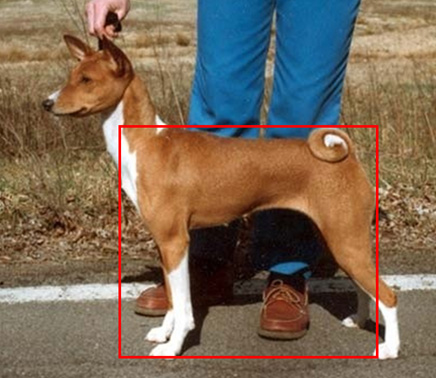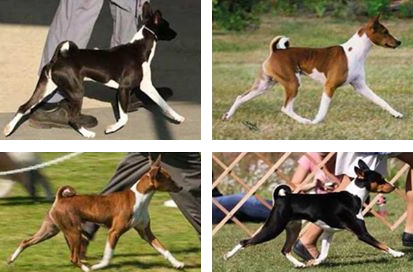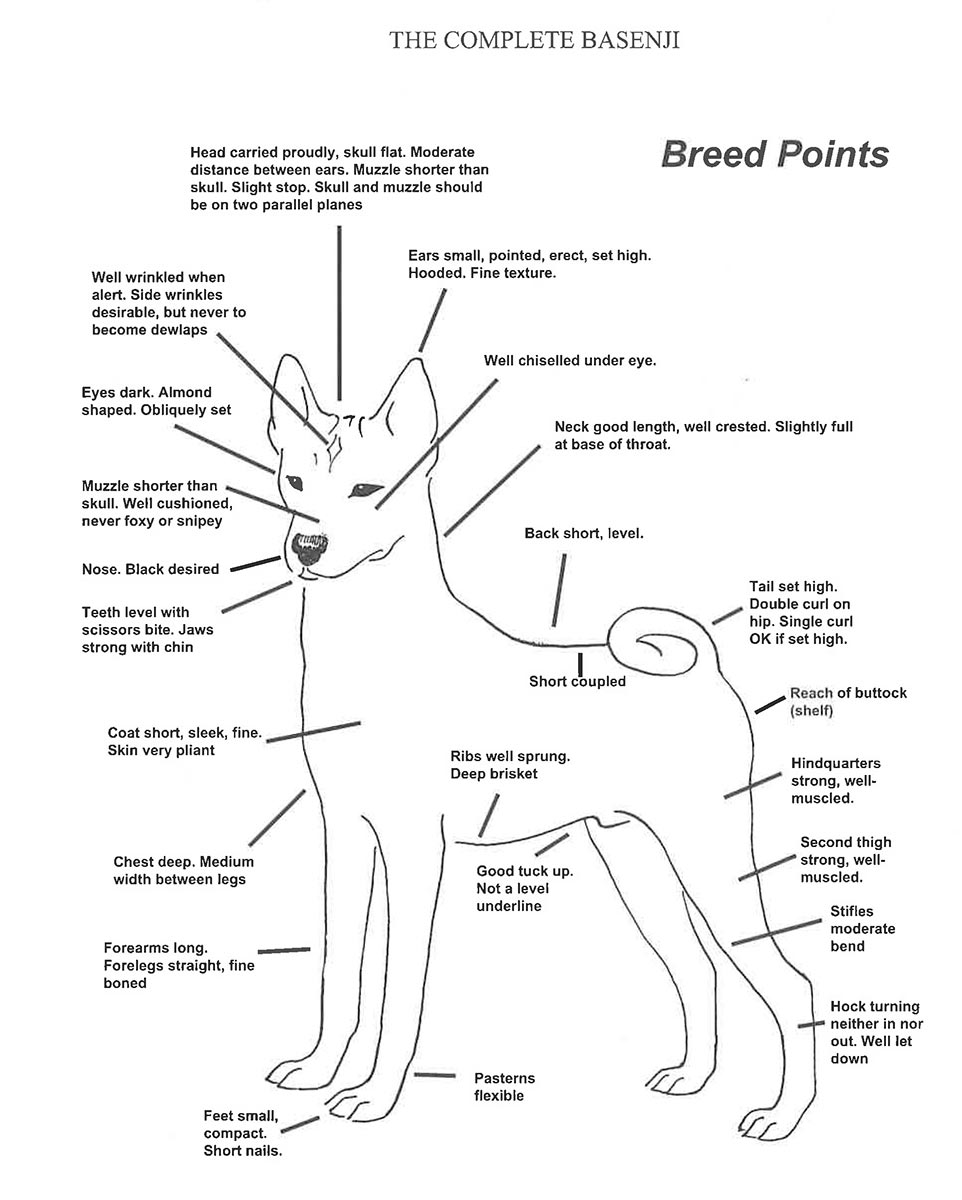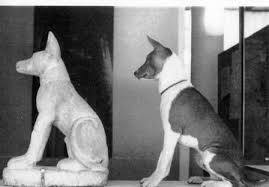Breed standard
The Basenji is a very ancient breed which dates back to the days of the Pharaohs. He is both a scent hound and a sighthound and is now used as a hunting dog by the natives in the Democratic Republic of the Congo and in the Southern Sudan primarily for flushing game. He will also kill. He must have the conformation and movement to enable him to do the job for which he was bred.
FCI-CLASSIFICATION
FCI-Standard N° 43
Group 5 Spitz and primitive types.
GENERAL APPEARANCE
Lightly built, finely boned aristocratic looking animal, high on legs compared with its length, always poised, alert and intelligent. Wrinkled head, with pricked ears, proudly carried on a well arched neck. Deep brisket runs up into a definite waist, tail tightly curled presenting a picture of a well-balanced dog of gazelle-like grace. The most important characteristics are his wrinkled forehead, his tightly curled tail lying over either thigh, and his gait. Basenjis are fastidious and will groom themselves like cats. This has been called a “cult breed”—small in numbers, but those lucky enough to own one do so with singular devotion.
The Basenji female only cycles once a year compared to twice a year for other domesticated dogs.
BEHAVIOUR/TEMPERAMENT
An intelligent, independent, but affectionate and alert breed.
Basenjis are known for being a very quiet breed; because they have flat larynxes, the dogs cannot bark, but is certainly not mute. When happy, he will yodel. Basenjis are well known for not particularly liking their own breed and will sometimes have a growl at unfamiliar Basenjis. He is a remarkably clean dog, hates being dirty, and possesses no “doggy” out dour.
Can be aloof with strangers.
HEAD
Fine and profuse wrinkles appearing on forehead when ears pricked; side wrinkles desirable but not exaggerated into dewlap; wrinkles more noticeable in puppies, but because of lack of shadowing, not as noticeable in tri colors and black basenjis. Remember the wrinkle is only present to adult dogs when the ears are pricked. Wrinkle is a very important characteristic of the breed and without it the head has lost Basenji type. Wrinkles are not as noticeable in tri colors or black and whites, don’t just say “he has a black head; it is not easy to see”.

CRANIAL REGION
Skull: Flat, well-chiseled and medium width, tapering towards the nose. Side lines of skull taper gradually towards mouth, giving a clean-cheeked appearance.
Stop: Slight.
FACIAL REGION
Nose: A black nose is greatly desired. Often during winter, a nose will develop a pinkish tinge is not desired.
Jaws/Teeth : Jaws strong with a perfect, regular and complete scissor bite, i.e. the upper teeth closely overlapping the lower teeth and set square in the jaws.
Eyes: Dark, almond-shaped; obliquely set, far-seeing and rather inscrutable in expression.
Ears: Small, pointed, erect and slightly hooded, of fine texture, set
well forward on top of head, tip of ear nearer center of skull than outside base. It is said that the Basenji with ears too small has not been born yet.
NECK
Strong and of good length, without thickness, well crested and slightly full at base of throat with a graceful curve accentuating crest. Well set into shoulders giving head a « lofty » carriage.
BODY
Balanced.
Back : Short, level.
Loin : Short-coupled.
Chest : Deep brisket. Ribs well sprung, deep and oval.
Basenji is a hunting dog which must be capable of twisting and turning suddenly, the loin should not be too short as to hinder him in this function, nor too long to show slackness and weakness. Any length of body should come from the sloping shoulder and well developed hindquarters. The Basenji is basically a square dog, i.e. the distance from the front of the sternum (breast bone) to the point of the buttocks (pelvis) should not exceed the height at the withers.
THE DOG’S BODY SHOULD BE A SQUARE.

FRONT
The shoulders must be well laid back, muscular but not loaded and the points of the too close thus preventing the scapulae must be fairly close at the withers, but not head from being lowered to the ground. The humerus or upper arm should be approximately the same length as the scapulae to give the dog good front reach. Elbows should be firmly tucked against the brisket so as to form a straight line with the ribs. When viewed from the front, the elbows should be in line with the ribs and the legs should continue in a straight line to the ground. Three or four fingers’ width is a good guide. One should get a pictured of an inverted “U” between the front legs and not an invert “V”. Only a slight fore chest in front of the point of shoulder is required as a heavy, protruding “pigeon chested” front is completely wrong and detracts from the desired grace and elegance of this breed.
TAIL
High set, with posterior curve of buttock extending beyond root of tail giving a reach appearance to hindquarters. Curls tightly over spine and lies closely to thigh with a single or double curl. The set-on of the tail is more important than a double curl.
Never uncurl a Basenji’s tail when examining him, as some tails do have kinks in the bone due to the tight curl and it can be painful and upsetting to the dog if uncurled or handled roughly. If you wish to see the set-on, just lift the tail gently, and particularly look when the dog is in motion.
LIMBS
FOREQUARTERS :
General appearance : Forelegs straight with fine bone. Legs in a straight line to ground giving a medium
front.
Shoulders : Well laid back, muscular, not loaded.
Elbows : Tucked in against brisket. When viewed from front, elbows in line with ribs.
Forearm : Very long.
Pasterns : Good length, straight and flexible.
HINDQUARTERS :
General appearance : Strong and muscular.
Stifle : Moderately bent.
Second thigh : Long.
Hock : Well let down, turned neither in nor out.
Feet : Small, narrow and compact, with deep pads, well arched toes
and short nails.
COAT
The ideal is short, sleek and close, very fine and should appear velvety to the touch. This is self-explanatory. Scars should not be penalized. The skin is very pliant and can be felt easily by gently lifting the skin on the back of the dog.
COLOUR
They come in four colors – red/ white, black/ white, tricolor and brindle – all with white feet, white chest and white tip on tail. The desired red is a bright orange red but that is rarely seen now. However, the bright chestnut red is correct and far more attractive than the light red because of contrast. The white should be on the feet, chest and tail tip. White legs, blaze and white collar optional.

GAIT/MOVEMENT
Legs carried straight forward with a swift, long, tireless, swinging stride.
The Basenji is basically a trotting dog, but they are capable of short bursts of speed, and many are capable of a double suspension gallop with all four feet off the ground at once over short distances. Their working gait is an effortless trot and they must expend only a minimal amount of energy, as in their natural habitat they are sometimes required to hunt all day – without collapsing.
SIZE AND WEIGHT
Ideal height:
dogs 43 cm (17 ins) at withers,
bitches 40 cm (16 ins) at withers.
Ideal weight:
dogs 11 kg (24 lbs),
bitches 9 1/2 kg (21 lbs).
FAULTS
Coarse skull or muzzle. Domed or peaked skulls. Cheeki-ness. Round or light eyes. Low-set ears. Overshot or undershot mouths. Wide chest, barrel ribs. Wide hind movement. Heavy bone.
Thin, flat, open feet. Short in the leg. Cow hocks. Creams sables or off-colour, or any colours other than those defined above he heavily penalized.
DISQUALIFYING FAULTS
• Aggressive or overly shy dogs.
• Any dog clearly showing physical of behavioral abnormalities
shall be disqualified.
N.B.
• Male animals should have two apparently normal testicles fully descended into the scrotum.
• Only functionally and clinically healthy dogs, with breed typical conformation should be used for breeding.



